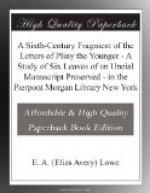that Professor Merrill’s path of argument causes
me to stumble. I readily admit that Aldus, in
editing a portion of text that no man had put into
print before him, fell back on conjecture when his
authority seemed not to make sense. But Merrill’s
lists need revision. He has included with Aldus’s
“willful deviations” from the true text
of
P certain readings that almost surely were
misprints (218, 12; 220, 3), some that may well be
(as 217, 28; 221, 12), one case in which Aldus has
retained an error of
P while
I emends
(221, 11), and several cases in which Aldus and
I
or
i emend in different ways an error of
P
(222, 14; 226, 5; 272, 4—not 5). In
one case he misquotes Aldus, when the latter really
has the reading that both Merrill and Keil indicate
as correct (276, 21); in another he fails to remark
that Aldus’s erroneous reading is supported
by
M (219,17). However, even after discounting
these and possibly other instances, a significant
array of conjectures remains. Still, it is not
fair to call the Parisinus Aldus’s
only
manuscript. We know that he had other material
in the six volumes of manuscripts and collated editions
sent him by Giocondo, as well as the latter’s
copy of
P. There could hardly have been
in this number a source superior to the Parisinus,
but Giocondo may have added here and there his own
or others’ conjectures, which Aldus adopted
unwisely, but at least not solely on his own authority;
the most apparent case of interpolation (224, 8) Keil
thought might have been a conjecture of Giocondo’s.
Further, if the general character of
P is represented
in _{Pi}_, Book X, as well as the beginning of Book
III, may have had variants by the second hand, sometimes
taken by Aldus and neglected, wisely, by Budaeus’s
transcriber.
[Footnote 76: P. 33.]
[Footnote 77: P. 30.]
[Sidenote: The Morgan fragment the best criterion
of Aldus]
With the discovery of the Morgan fragment, a new criterion
of Aldus is offered. I believe that it is the
surest starting-point from which to investigate Aldus’s
relation to his ancient manuscript. I admit that
for Book X, Avantius and the Bodleian volume in its
added parts are better authorities for the Parisinus
than is Aldus. I admit that Aldus resorted throughout
the text of the Letters—in some cases
unhappily—to the customary editorial privilege
of emendation. But I nevertheless maintain that
for the entire text he is a much better authority than
the Bodleian volume as a whole, and that he should
be given, not absolute confidence, but far more confidence
than editors have thus far allowed him. Nor is
the section of text preserved in the fragment of small
significance for our purpose. Indeed, both for
Aldus and in general, I think it even more valuable
than a corresponding amount of Book X would be.
We could wish that it were longer, but at least it
includes a number of crucial readings and above all




